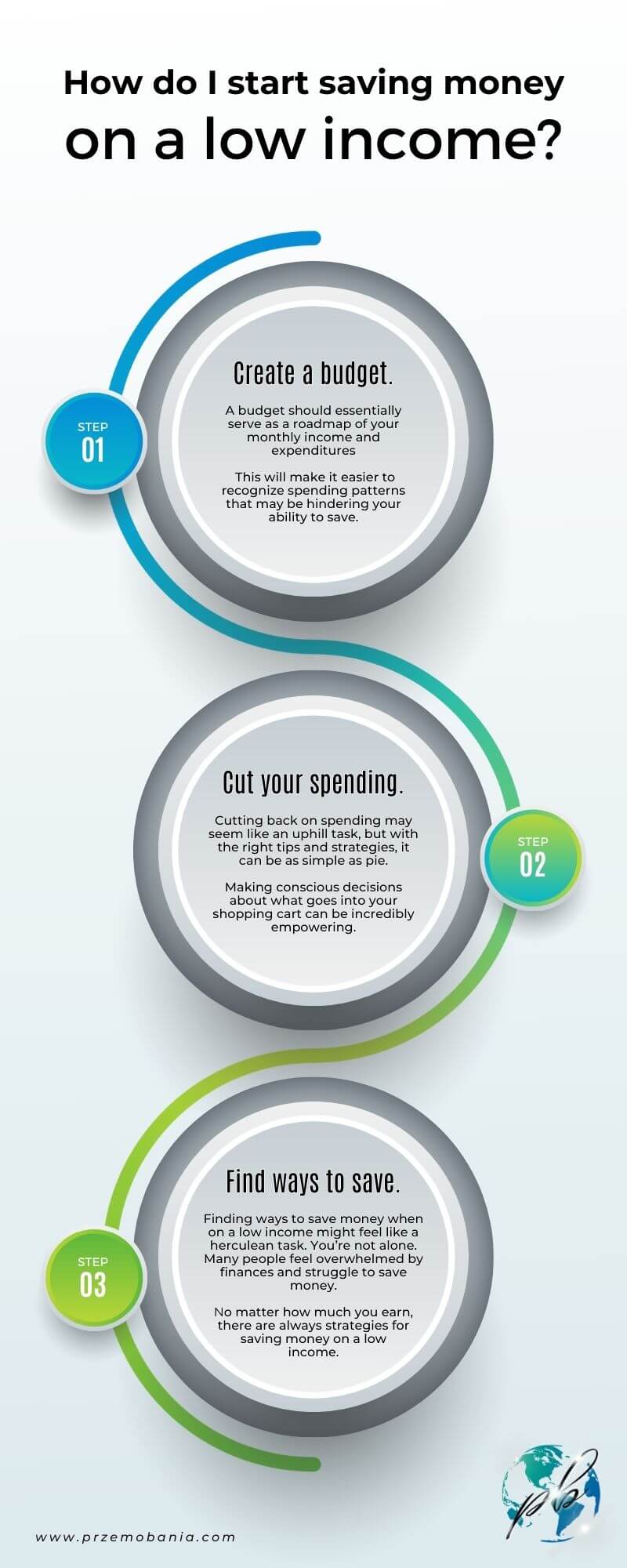How do I start saving money on a low income?
For many, the prospect of saving money, particularly on a low income, can seem like a daunting task. This struggle isn’t exclusive. Millions across the globe grapple with how to stash away their cash for the future when immediate financial demands constantly loom large. However daunting it may seem, it’s certainly not an impossible feat. Here’s how you can start saving money on a low income:
Start by tracking all your expenses to understand where your money goes. Identify and cut back on non-essential costs. Save small amounts regularly, even if it’s a small percentage of your income. Consider increasing your income through side jobs if possible.
The trick is to approach this endeavor with a well-thought-out plan and unyielding determination. When we talk about “saving money”, we generally refer to the act of setting aside a portion of our income or resources for future use rather than spending it immediately.
For low-income families, this concept might seem alien because they are already overwhelmed by finances — often living paycheck to paycheck just to make ends meet. However, there are ways around this predicament.
Many assume that saving money requires having a substantial income to start with – which is not necessarily true! In fact, saving money on a low income is entirely possible if you know some spending hacks and budget tips tailored to your situation.
Remember – it’s not about how much you earn but rather how well you manage what you have. Government assistance programs exist specifically for helping low-income people manage their finances better.
Additionally, non-profit organizations also offer guidance and financial literacy programs aimed at instilling smart money habits among those struggling financially. Tactics like cutting back on unnecessary expenses or finding alternative cost-effective options can significantly reduce your outgoings while not compromising your lifestyle drastically.
For instance, swapping branded goods with generic ones saves quite an amount over time!
When paired with other strategies for saving money on a low income – like taking advantage of discounts, coupons, or sales – even small savings add up over time granting you a path toward financial freedom.
: yes, it’s challenging but certainly not impossible to save money on a low income. The idea here is never to feel threatened or overwhelmed by your finances but instead gradually learn and practice the art of frugality through careful planning and disciplined execution.
What saving money means?
So, what does saving money really mean?
It’s a concept that might seem straightforward, but it can often be obscured by financial jargon or the pressures of daily living. Essentially, saving money means setting aside a portion of your income or earnings for future use.
Instead of using all your resources straight away, you’re making a conscious decision to save some for later. Now let’s dig deeper into this concept especially considering you’re trying to save money on a low income.
In such circumstances, every penny counts, and even the smallest savings can make a big difference. It’s not just about hoarding coins in a jar — it involves careful budgeting, cutting back on spending where possible, and finding smart strategies for reducing costs.
The struggle to save money is real when you’re dealing with low wages or living paycheck to paycheck. You might feel overwhelmed by finances and think that saving is out of reach.
But don’t lose hope – there are ways you can stretch your income further than you think!
For instance, non-profit organizations exist specifically to help low-income families manage their finances better.
Even though it may seem daunting at first glance – especially when struggling to make ends meet – it’s important to remember that every little bit helps when trying to build up savings.
There are tips for saving money on a low income which ranges from small daily changes like packing lunch instead of buying it or utilizing government assistance available specifically for low-income people.
One thing’s certain – achieving financial freedom requires persistence and determination irrespective of one’s income level; but more so if the earnings are modest.
Finding ways to save money for people with low incomes is not only about effective budgeting but also creating a lifestyle centered around thoughtful spending and healthy monetary habits which ultimately lead to financial independence.

How saving money can be challenging for low-income people?
While it’s true that saving money often requires both dedication and determination, the task becomes considerably more difficult when income is low. The struggle to meet basic daily needs can be overwhelming for people with limited financial resources.
They often find themselves caught in a cycle that many refer to as “living paycheck to paycheck”, where the entirety of their earnings is absorbed by rent, utilities, food, and other necessities, leaving little or nothing for savings. Despite these challenges though, achieving some level of financial freedom isn’t impossible.
However, it does necessitate a keen understanding of personal finances and a willingness to make changes. Often, individuals on low incomes feel overwhelmed by finances due to a lack of knowledge or guidance about how best to manage their money.
But there are numerous resources available—ranging from free online tools and budgeting apps to community-based non-profit organizations—that can help these individuals learn essential money management skills. For those figuring out how to save money on a low income, one effective strategy is finding small ways to cut back on spending.
Spending hacks come in various forms. It could mean giving up unnecessary extras like cable TV or daily coffee shop visits or finding cheaper alternatives for everyday items such as food and clothing.
Even seemingly insignificant reductions in expenses can add up over time into substantial savings. Budgeting also plays a significant role in helping low-income families save more effectively.
A well-planned budget not only helps them understand their spending habits better but also highlights areas where they might be inadvertently wasting money.
By incorporating practical budget tips into their routine—for instance, tracking every single expenditure no matter how small or setting aside a specific amount at the start of each month—they might discover they have more capacity for saving than previously thought.
Moreover, several government assistance programs exist specifically designed for aiding low-income individuals and families struggling with their finances. Alongside this governmental support, numerous non-profit organizations offer services like financial counseling and literacy training that provide invaluable insights into strategies for saving money on a low income.
So yes, saving when your income is limited can indeed seem daunting at first glance but don’t lose heart!
With the right mindset supplemented by practical strategies such as reducing expenditures wherever possible and establishing an efficient budget system not only will aid you save money on a low income but also move closer to achieving your goal of financial independence.
Is it possible to save money on a low income?
This question weighs heavy on many minds, especially those who are already overwhelmed by finances.
While the task may seem Herculean, saving money on a low income is not only possible but can also pave the path towards financial freedom. There are multiple strategies for saving money on a low income, and even if they seem small at first glance, these little drops can fill up an ocean over time.
The first step is embracing the concept of budgeting. Having a budget for low-income people doesn’t require any special financial acumen, it’s about understanding your income and expenditures and making sure that you’re not spending more than you earn.
Budget tips include tracking your expenses for a month to identify where your money goes, cutting back on non-essential spending, and planning for unexpected costs. Cutting back on spending for low-income people might sound daunting at first, but when done right it can free up significant resources that you can redirect towards savings.
Spending hacks could include anything from choosing store-brand products over name brands in grocery stores to swapping out cable TV subscriptions with more affordable digital streaming services. But what do you do when all corners have been cut?
There’s no need to despair!
Finding ways to save money for low-income people goes beyond just reducing expenditures, it’s also about exploring new avenues of increasing income or tapping into available resources.
Government assistance for low-income people could be one avenue worth considering if you qualify. Non-profit organizations for low-income people are another resource that often goes overlooked.
These organizations often offer community programs aimed at supporting struggling families through financial literacy education or providing direct aid like food banks or clothing drives. Don’t forget that saving is not about depriving yourself of pleasure but rather about ensuring future stability and peace of mind.
If you’re struggling to save money now, remember each step made today will bring that dream closer tomorrow!
Don’t underestimate the impact of these tips for saving money on a low income – with resilience and commitment, even those small steps can lead to big changes over time.

Step 1: Create a budget.
Embarking on the journey to financial freedom often starts with a simple but crucial step – creating a budget. If you feel overwhelmed by finances, this can provide much-needed clarity and control.
It’s key for everyone, but when you’re learning how to save money on a low income, it’s absolutely essential. Forget what you’ve heard about budgets being restrictive or complicated – they are merely tools that help map out where your hard-earned money is going and identify potential areas for savings.
A budget should essentially serve as a roadmap of your monthly income and expenditures. This will make it easier to recognize spending patterns that may be hindering your ability to save.
To start crafting this blueprint for financial freedom, list all sources of income coming in, such as wages from jobs or government assistance for low-income people. Next comes the part that most may find daunting — detailing your expenses.
Make sure to include everything: rent or mortgage payments, utilities, groceries, transportation costs, healthcare expenses, etc., without leaving anything out no matter how insignificant it might seem at first glance. Once everything is laid out clearly before you in black and white, chances are high you’ll spot areas where expenditure exceeds necessity.
These are the potential gold mines in our quest of finding ways to save money for low-income people. This reality check often prompts a reevaluation of spending habits – are there any non-essential items that can be cut back?
For instance, some people discover they’re shelling out more than they realized on dining out or entertainment subscriptions which can add up over time without careful monitoring. Don’t feel discouraged if the numbers initially don’t add up favorably; many individuals and families have felt the same way when starting their saving journey.
Remember – every penny saved is a penny earned!
Apply these budget tips with patience and consistency – soon enough you’ll find yourself making significant strides towards your financial goals!
After understanding your current financial situation through a thorough analysis of your budget breakdowns.
Consider reaching out to non-profit organizations for low-income people who offer services like counseling on managing finances effectively, developing better spending habits, and providing tools & resources to track incomes & expenses, thus cultivating overall better strategies for saving money on a low income.
They can provide personalized advice based on individual circumstances which is incredibly valuable especially if one feels lost wading through their monetary maze.
Remember that embarking on this journey isn’t about denying ourselves enjoyment today, but rather securing our future. So chin up, and embrace these changes wholeheartedly because financial freedom awaits those who persist!
Step 2: Cut your spending.
The journey to financial freedom often feels like a tightrope walk, especially when you are struggling to save money on a low income. The good news is that it’s not impossible – it all begins with scrutinizing your expenditure.
Cutting back on spending may seem like an uphill task, but with the right tips and strategies, it can be as simple as pie. Firstly, consider your current lifestyle expenses.
- Do you buy takeout every day?
- Do you have subscriptions for services that you seldom use?
Perhaps there’s a gym membership gathering dust or magazines piling up unread. These are areas where cutting back on spending can make a massive difference.
Try cooking meals at home instead of ordering food, cancel unused subscriptions, and utilize public spaces for exercise instead of paying hefty gym fees. Another effective strategy for saving money on a low income is to limit unplanned shopping trips.
I strongly recommend you change your passion into a side hustle.
Impulse buying often leads to unnecessary expenses that deplete our funds faster than we realize. So the next time you feel tempted by those flashy sales signs or online deals, ask yourself – “Do I really need this?”
Making conscious decisions about what goes into your shopping cart can be incredibly empowering and instrumental in achieving financial freedom.
Also, remember to keep an eye out for discounts and coupons which can help immensely in lowering the cost of essential items. Look out for sales during off-seasons – buying winter clothes just as spring arrives or stocking up school supplies right after school starts could save you significant amounts of money over time.
Non-profit organizations also offer assistance programs specifically designed to help low-income families manage their finances better. Such organizations provide free or low-cost services such as budget counseling, financial education classes, and even assistance with utility bills and housing costs.
But importantly, government assistance programs are there too if things get really tough. If you’re overwhelmed by finances and finding ways to save money seems too daunting a task then these programs could be the safety net that keeps your head above water while you figure things out.
While saving money on a low income might seem challenging initially, especially when every penny counts. Persistence pays off in the end whether through budget tips or smart spending hacks.
By making informed decisions about where your money is going each month – cutting back on non-essential expenditures – it’s possible to build up savings over time achieving greater economic stability despite having limited resources.
Step 3: Find ways to save money.
Finding ways to save money when on a low income might feel like a herculean task. You’re not alone. Many people feel overwhelmed by finances and struggle to save money.
But remember, no matter how much you earn, there are always strategies for saving money on a low income. The first tip is all about being resourceful with your resources.
One strategy could be shopping at second-hand stores or utilizing non-profit organizations designed for low-income people that often give out clothes, food, and other essential items. This way, you’re cutting back on spending for low-income people without compromising your needs.
Next is the principle of delayed gratification – it’s also an excellent way to save money on a low income. Say you’ve been eyeing this new gadget or clothing piece that just got released – instead of buying it immediately, why not wait?
More often than not, these items go on sale after a few months. By waiting, you can get the same item for less!
It’s one of those spending hacks that work wonders. Another avenue one should consider involves tapping into government assistance programs specifically tailored for low-income individuals or families.
Such resources can range from food stamps to utility bill assistance and more! In many cases, these government-based aids can help alleviate some of the financial burdens and allow room to breathe in your budget plan.
Yet importantly, it’s about making small changes in your daily habits that add up over time!
For instance:
- Plan meals ahead so you aren’t tempted by last-minute takeouts.
- Walk or bike short distances instead of driving.
- Switch off lights when leaving a room.
- Unplug devices when they’re not in use.
These might seem insignificant but trust me – they do add up!
Achieving financial freedom doesn’t necessarily mean earning more. Sometimes it’s about finding smart ways within your means!
So don’t feel disheartened if you’re struggling to save money – with these budget tips tailored for individuals with lower incomes in mind, hopefully managing finances will become less intimidating!

Setting up a savings account.
When it comes to budget tips and strategies for saving money on a low income, the first step is often setting up a savings account. You may be thinking, “How can I possibly save when I’m already overwhelmed by finances?”
Be assured, you’re not alone in this boat.
Many low-income families share this apprehension. But with the right approach and mindset, it’s absolutely achievable.
Look at it this way—saving money is like giving your future self a gift. Opening a savings account can be the first significant step towards securing that gift.
In fact, many banks offer options tailored specifically for those who may be struggling to save money on their earnings. Choose an account with no minimum balance requirement and no monthly fees if possible.
Once you have your savings account set up, consider setting up automatic transfers from your checking account into this new savings one. This way you’re constantly putting something away without even having to think about it!
It’s one of several tried-and-tested money-saving ideas which work for most people. Remember, saving isn’t just about stashing away large sums of money – every little bit counts!
Even if you start by depositing just $5 or $10 each week into this account, over time it adds up. This isn’t just cutting back on spending for low-income people; consider it as investing in yourself and your future financial freedom.
Don’t be shy about seeking advice or help when needed!
There are non-profit organizations for low-income people providing assistance and guidance on how to save money on a low income.
You might qualify for government assistance specially meant for low-income families as well or learn some spending hacks that make managing finances easier than before. So there we have it – setting up a savings account could be the kickstart needed towards better financial health and stability in life irrespective of your income level.
Using a money-saving app.
We live in a digital age where technology has paved the way for many conveniences, including financial management. One of these perks is the availability of money-saving apps designed to help people gain more control over their finances.
For those asking “how do I start saving money on a low income?” these applications can certainly be beneficial.
Money-saving apps have diverse features that can assist with budgeting, spending tracking, and even automating savings.
Many even offer insights into your spending habits, helping you identify areas where you might be overspending and offering strategies for saving money on a low income. They could provide the very answers you’re looking for when you feel overwhelmed by finances.
Take advantage of these tools as they can help keep track of every penny spent, making it easier for low-income families to strategize their budget effectively. Most of these apps are user-friendly with easy-to-navigate interfaces so that anyone—regardless of their tech knowledge—can make good use of them.
One particular feature often found in these apps is an automatic savings option. This feature allows users to set aside a predetermined amount or percentage of their income automatically into a savings account each time they get paid—making it easier than ever to finally start building up those emergency funds or saving towards financial freedom.
While using such an app may not immediately solve all your financial struggles or instantly unleash an influx of wealth into your life, it definitely equips you with valuable insights and practical tips for saving money on a low income.
Moreover, many such applications are free or come at a nominal charge which makes them accessible even to those who might otherwise be struggling to save money.
Additionally, several non-profit organizations provide assistance in this area as part of their services for individuals from low-income backgrounds. They share budget tips and spending hacks which could be just the lifeline one needs when feeling submerged under financial pressures.
Saving while earning a limited income may seem challenging but remember that it’s not impossible, there are resources available including government assistance for low-income people designed specifically to support those finding ways to save money despite their limited means.
So whether you’re seeking ways on cutting back on spending or finding new avenues like side jobs for extra income, remember the key is not merely about making more but also about how well we manage what we have – something that budgeting and money-saving apps can aid significantly in achieving!
Participating in a savings challenge.
Entering a savings challenge can be an inspiring and effective method to start putting away some money, even on a low income. The principle is straightforward – you commit to saving a certain amount each week or month and stick to it, regardless of your circumstances. This could be as little as $1 a week or as much as your budget allows.
The critical factor is consistency and discipline, making sure you stick to your commitment.
Many non-profit organizations for low-income people offer savings challenges that are specifically designed for individuals struggling with financial constraints.
These challenges can provide motivation, support, and sometimes even match funds for low-income families committed to improving their financial situation. Participating in these initiatives not only helps you kick-start a savings habit but also fosters a sense of community among those who are similarly struggling with their finances.
It’s comforting to know that you’re not alone when feeling overwhelmed by finances, and sharing tips and experiences can be enormously helpful. It’s essential to remember that every little bit helps when it comes to saving money on a low income.
The goal isn’t necessarily about accumulating large sums, instead, it’s about creating habits conducive to long-term financial freedom. While the amounts may seem insignificant at first glance, over time they add up significantly.
If you’re finding the challenge too difficult or causing additional stress due to limited resources, don’t hesitate to reach out for help from non-profit organizations or government assistance for low-income people which could help alleviate immediate burdens while providing guidance towards more sustainable solutions.
So whether you’re cutting back on spending by cooking more meals at home or implementing some spending hacks like walking instead of using public transport whenever possible – participating in a savings challenge can be an empowering step towards gaining control over your finances, from merely surviving paycheck-to-paycheck into gradually building up your financial resilience.

Finding a side-hustle job.
In our modern economy, it’s not uncommon to find people juggling more than one job in an effort to make ends meet.
A side-hustle job can be a game-changer for low-income individuals who are striving to save money. The key lies in finding something you’re good at or enjoy doing and being able to monetize it effectively.
For example, if you have a penchant for writing, freelancing could generate some extra revenue. Or if gardening is your hobby, why not sell your produce at a local farmer’s market?
This venture might just be the proverbial silver lining you’ve been searching for. Remember not all side jobs require an array of skills or previous experience, sometimes it simply takes initiative and determination.
It could be starting a small cleaning business, dog walking, or even house-sitting for vacationers in your neighborhood. Such opportunities don’t just supplement income but also offer flexibility which is crucial when balancing multiple responsibilities.
When considering a side-hustle job, don’t underestimate the potential inherent in modern technology either. The digital age has opened up numerous possibilities – from online tutoring and graphic designing to blogging and selling handmade crafts on platforms like Etsy.
If technology is your forte, this could be an advantageous route toward reaching a brighter financial future. While diving into these opportunities might seem daunting initially, especially when you’re already struggling with managing finances on a low income, remember that every bit helps.
It may take some time before the additional income reflects significantly on your savings account but patience and persistence often pay off. The ultimate goal of taking up such ventures goes beyond just generating additional income; it nudges one towards achieving financial freedom – no small feat when operating within the constraints of minimal earnings!
While government assistance programs are indeed helpful for low-income families they are often meant as temporary measures rather than permanent solutions. So explore these avenues with vigor and determination as they can change the trajectory of your financial health immensely.
On that note ending with some budget tips:
- spend wisely by noting necessary expenses while cutting back on spending extravagantly
- use financial aid provided by non-profit organizations judiciously
- learn about spending hacks from reliable sources
Keep looking out for strategies to save money on a low income, because they do exist!
As overwhelming as finances may seem now remember there’s always hope when it comes to saving money even if you’re in a low-income bracket.
Selling unwanted items.
As we navigate through the labyrinth of strategies for saving money on a low income, one aspect that’s often overlooked is the potential nest egg we have in our own homes – selling unwanted items. You might be surprised by how much you can rake in by simply clearing out your clutter.
In every household, there are always items gathering dust somewhere.
They could be old clothes that don’t fit anymore, redundant appliances, books you’ve already read, or perhaps some forgotten childhood toys. These are all treasures waiting to be discovered and converted into cold hard cash.
Just imagine having a garage sale or listing those items on online platforms – they could turn into a substantial boost for your savings. The digital age has made it even easier to find buyers for such items; websites like eBay and apps like Letgo allow you to sell your things right from the comfort of your home.
So, if you’re feeling overwhelmed by finances with limited income streams, take a moment to consider this money-saving idea. It’s essentially putting money back in your pocket without making any additional purchases.
But what if you can’t sell everything?
That’s where non-profit organizations come into play.
Many are happy to accept used goods as donations and these can serve dual purposes – not only do you de-clutter but also help those who are less fortunate than yourself – a poignant reminder that despite our own struggles with budgeting on low-income, there’s always someone who could benefit from our small acts of kindness.
Remember though that capitalizing on your excess belongings isn’t just about making quick bucks but also about adopting new habits such as resisting impulse buying – one of the key budget tips for low-income people. After all, it would defeat the purpose if we were going to refill empty spaces with new unnecessary purchases.
It’s all part of finding ways to save money for low-income people and inching closer toward precious financial freedom.
Selling unwanted items is more than just an emergency fund strategy – it encourages mindful purchasing habits while emphasizing simplicity over materialistic indulgence – both crucial elements when striving for long-term financial stability despite being burdened by low income.
Asking for help from family and friends.
In the bustling tide of life, we sometimes find ourselves treading water at the deep end of financial difficulties. It happens to the best of us, especially when we’re trying to save money on a low income.
In such situations, it’s not a sign of weakness to seek help from those around us. Many people find themselves overwhelmed by finances and it’s rather common among low-income families.
It is said that a problem shared is a problem halved, and this wisdom holds true, especially in financial matters. We all have that one friend or family member who seems to have an uncanny knack for stretching their dollar beyond what seems possible.
They’ve got the budget tips down pat and are adept at finding ways to save money for low-income people through spending hacks and money-saving ideas. Humbling yourself enough to ask them for advice or assistance can be your ticket toward taking control of your finances once more.
You’d be surprised at how generous people can be when they know you’re genuinely struggling to save money on a low income and are actively seeking strategies for saving money on a low income.
You don’t need an elaborate sob story, just being open about your situation can tug at their heartstrings enough for them to offer some sort of help, whether that’s helping you devise a budget for low-income people, recommending non-profit organizations for low-income people or even giving you an interest-free loan.
While cutting back on spending is critical in achieving financial freedom, there will always be certain necessities where costs can’t be compromised – think medical bills or education fees.
In these instances, turning towards government assistance programs aimed specifically at helping low-income individuals and families may hold the key to lifting yourself out of monetary troubles without sacrificing essential needs.
It might feel awkward asking others for help but remember – everyone fumbles with their finances at one point or another, even if they don’t admit it publicly. By reaching out, you’re not only getting immediate aid but also learning valuable lessons on how to save money on a low income which could benefit you (and others) in the long run.

Conclusion on how saving money is possible on a low income.
In the hustle of daily life, many individuals often find themselves overwhelmed by finances, especially those who are regarded as part of the low-income group.
Struggling to save money has become a norm, a situation that seems almost impossible to escape. However, contrary to popular belief, saving money on a low income is not only possible but also manageable with the right strategies and mindset.
There are several strategies for saving money on a low income. One of the most effective models is creating and following a budget specifically designed for low-income people.
This budget should account for all your essential expenses such as rent or mortgage payments, utilities, groceries, and transportation costs. After meeting these necessities, what remains can be divided into smaller categories for non-essential spending and savings.
While it’s true that there’s no one-size-fits-all solution when it comes to financial management, there are various spending hacks that can make it easier for you to save money even with limited resources.
These could be as simple as opting for own-brand products in grocery stores rather than big-name brands or re-evaluating your service providers such as the internet or insurance carriers for cheaper options.
It’s all about getting creative with how you manage your funds.
Besides these tips and tricks at an individual level, there’s also support available from outside sources like government assistance programs specifically formed for low-income families and individuals.
There are non-profit organizations dedicated to helping those struggling financially through food banks or offering free financial advice catering specifically to those trying to find ways to save money on a low income. Conclusively speaking – yes!
It is entirely possible to save money on a low income if you’re committed enough to achieving financial freedom regardless of your current circumstances.
Remember that while saving might seem difficult now – every little bit counts towards building up your nest egg over time – you’re working toward something bigger – peace of mind knowing that you have some reserves stashed away if life throws an unexpected curveball at you.
Remember this: your income does not solely define your ability to save; instead it’s more about managing what resources you have creatively and efficiently while leveraging any external help accessible.
With careful planning and adherence to smart financial practices like cutting back on non-essential spending where possible, everyday frugality combined with long-term planning can pave the way towards financial independence even amidst the confines of minimal earnings.
FAQ about saving money on a low income.
Words of encouragement.
For many people, the path to financial freedom may seem littered with obstacles, particularly when you’re struggling to save money on a low income. It’s easy to feel overwhelmed by finances, especially when your income just seems to cover the basics.
But I want you to know that saving money is not an impossible task. Even on a low income, there are ways that you can start putting aside a little something for your future.
One of the most basic budget tips is simply this: create one. Crafting a budget for low-income people isn’t about restricting what you spend, rather it’s about understanding where your money goes and planning how best to use it.
It is possible!
And cutting back on spending for low-income people doesn’t have to mean sacrificing everything you enjoy.
Discovering spending hacks and finding ways to save money for low-income people can be as simple as switching brands at the grocery store or canceling unused subscriptions. Now let’s talk about non-profit organizations for low-income people and government assistance for low-income people.
If your situation feels dire, remember there are resources out there designed specifically with you in mind.
These organizations can help with things like food programs, housing assistance, or even provide financial counseling services that can offer great advice on strategies for saving money on a low income.
But finding financial freedom isn’t just about cutting costs – it’s also about finding ways to increase your wealth as well. You might consider looking into side jobs or selling unwanted items online which could turn into some extra cash flow while helping clear out clutter from your home too!
And if these aren’t viable options?
Then reach out.
Sometimes asking family members or friends if they have any work available can lead right back here – making more money while learning new skills too!
So remember this: how to save money on a low income isn’t some unsolvable mystery – it’s completely achievable with some patience and determination!
And yes, I understand if right now all these tips for saving money on a low income feel overwhelming but take them one at a time and slowly integrate them into your life – each small step will bring you closer to achieving financial stability.
Never forget that every journey begins with taking the first step forward!
The fact that you’re here seeking knowledge already says so much about your strength of character and commitment towards bettering yourself financially – two qualities necessary in achieving success in any endeavor. Trust me when I say this – no one has ever regretted taking steps towards establishing their financial future!
Today might be filled with struggles but remember tomorrow holds potential rewards too!
Keep pursuing your goal of saving money diligently even when times get tough because progress may be slow but it’s progress nonetheless!
You CAN save money on a low income and eventually achieve financial freedom. So don’t lose hope or give up because every penny saved counts no matter how small it seems now!
Take courage from knowing countless individuals from similar backgrounds have successfully navigated this path before – and like them, YOU too can overcome these hurdles & accomplish all that you set out to achieve!


Przemo Bania is a blogger and writer who helps people get out of their traditional jobs to start a blogging career. Przemo also runs a health blog advocating for endometriosis and fibromyalgia…

